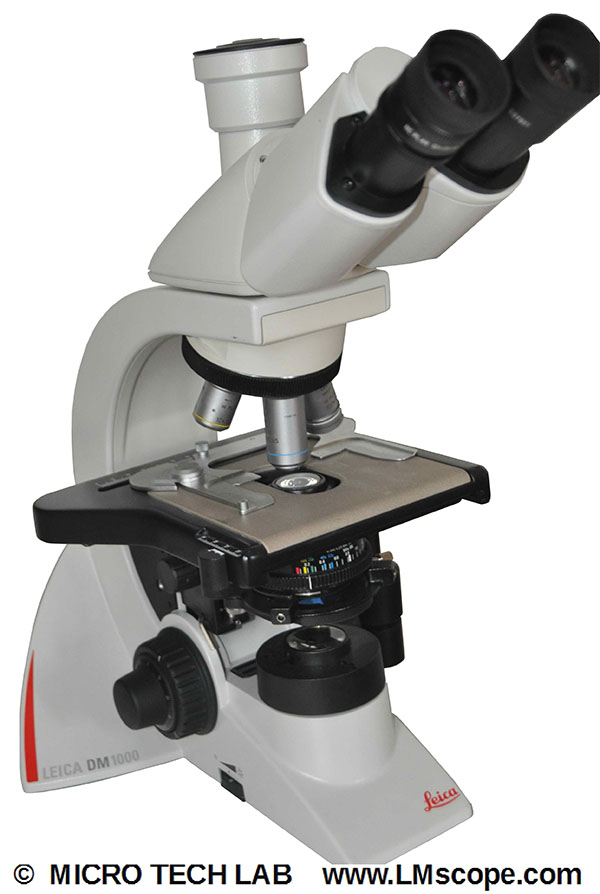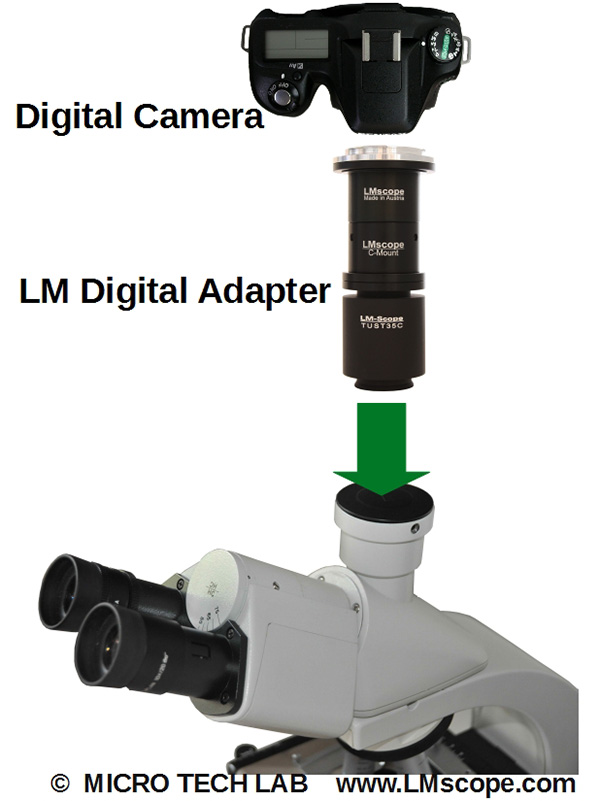

The Leica DM1000 research microscope includes many of the features found on its “bigger brothers”
Leica’s upright DM1000 research microscope (the successor to the Leica DMLS) is the “smallest member” of Leica’s family of DM1000-3000 series microscopes, a range that includes the DM1000, DM2000, DM2500 and DM3000 models. Other than differential interference contrast (DIC), the DM1000 offers all common contrasting methods (bright field, dark field, phase contrast, polarisation and fluorescence).
All current DSLR and system cameras can be attached to Leica’s DM series microscopes quickly and easily using LM digital adapters. This makes it possible to achieve a maximum of image quality.

To ensure optimal ergonomic conditions, the development team for Leica’s DM series were especially inventive: beyond different tubes (ergo tube 15° viewing angle/FOV 22; standard tube viewing angle/FOV 30°/22; ergo tilting eyetube FOV 25 (long); ergo tilting eyetube FOV 22 (short) and advanced ergo tilting eyetube FOV 22), these instruments also offer height-adjustable focus knobs, symmetrical operation, an ergo lift module, adjustable-height hand rests and rapid changeover from right- to left-handed operation. These thoughtful enhancements make working with DM series microscopes as comfortable and effortless as possible.
Of course, the following trinocular phototubes are also available for these high-quality instruments:
- Trinocular ergo tilting photo tube 50/50 FOV 22
- Trinocular ergo tilting photo tube 100/100 FOV 25
- Trinocular ergo tilting photo tube 50/50 FOV 25
- BDT25 0/50/100 dual port option FOV 25
- EDT22 50/50 FOV 22
Our LM digital adapters enable these microscopes to produce excellent photos and video recordings of microscopic images using all types of DSLR cameras, mirrorless system cameras and C-mount cameras.

The Leica DM1000 is typically equipped with a 12-volt, 30-watt halogen lamp that can be replaced easily via the lamp socket, which enables Köhler illumination. The Leica DM1000 is also available with LED illumination, which provides a constant colour temperature without heating up the specimen. A particularly novel feature is the optional flexible solar panel, which delivers power to the DM1000’s rechargeable LED battery. This feature enables mobile use for field applications.
The Leica DM1000 comes with a 5-fold objective turret, which accommodates Leica’s brightness-synchronized objective series HI Plan SL 4x, 10x and 40x. Leica recommends the HI PLAN 10x objective as being particularly well suited for cytology applications because of its extremely long working distance of 12 mm. The screening objective with 1.25x magnification allows specimens to be surveyed and recorded quickly and easily. Of course, users can choose objectives from any Leica performance class.
Leica microscopes are renowned for their longevity, particularly since all mechanical components are maintenance free and designed for a long service life. That level of endurance is also ensured by the microscope’s stage surface, which is manufactured from a wear-resistant ceramic material.
Conclusion: Leica’s DM1000 ticks all the boxes for use with photomicrography applications. Those who can afford its base price of over € 3,300 can even take the DM1000 along on field trips to examine specimens in their natural environment. As a testament to this instrument’s quality and durability, however, the current market for used Leica microscopes is generally very small.
Photography:
Fitting the microscope to digital single-lens reflex (DSLR), mirrorless interchangeable-lens cameras (MILC ), digital single-lens mirrorless (DSLM) or C-mount cameras is easy with our LM digital SLR adapters, which feature a plan achromatic optical system. Our products make it possible to capture top-quality microscope images. To help you select the adapter that is right for your camera, we have set up an online configurator on our website. You can also email us – ideally with attached photographs of your microscope.
Modern DSLR and single-lens mirrorless (DSLM) offer the latest technology and are generally very well suited for microscopy applications. Most of them can be controlled remotely via PC/Mac. Because of their high sales volumes, they offer an excellent price/performance ratio compared to special-purpose microscope cameras.
Features of top DSLR and single-lens mirrorless cameras (DSLM):
- Large, powerful full-frame sensors (36 x 24 mm)
- Sensor resolution of 61 megapixels or 240 megapixels with Pixel Shift technology
- High light sensitivity (ISO 400,000+)
- Extensive dynamic range (up to 15 aperture stops/f-stops)
- Short exposure times (1/8000 second) up to 1/32,000 seconds using the digital shutter
- 4K Ultra HD or 8K Ultra HD video function
- Live video capture on external monitors in ultra HD quality
In most cases, these cameras are significantly more powerful than microscope cameras with smaller sensors (1/2" or 2/3"). On our website you will find our current camera recommendations and a camera ranking which is specifically tailored to microscopy applications.
New LM Digital Adapter for: Nikon Z9 / Nikon Z8 / Sony Alpha 7R V / Sony Alpha 1 / Sony FX3 Cinema Line / Sony Alpha 9 II (ILCE-9M2) / Sony Alpha 9 / Nikon D6 / Canon EOS R3 / Canon EOS R6 Mark II / Canon EOS R8 / Sony Alpha 7R IV / Canon EOS R5 / Sony Alpha 7S II / Sony Alpha 7S III / Sony Alpha 7R III / Canon EOS R6 / Nikon Z6 / Nikon Z6II / Sony Alpha 7R II / Nikon Z7 / Nikon Z7II / Canon EOS R / Canon EOS Ra (Astro) / Nikon Z5 / Sony Alpha 7C / Canon EOS RP / Sony Alpha 7S / Canon EOS R7 / Leica SL2-S / Canon EOS R10 / Canon EOS 1D X Mark III / Nikon Z50 / Nikon Z30 / Nikon Z fc / Nikon D850 / Canon EOS 1D X Mark II / Nikon D780 / Olympus OM-1 / Sony Alpha 7III / Olympus OM-D E-M1 Mark III / Canon EOS R100 / Sony Alpha 6700 / Nikon D5 / Sony Alpha 6600 / Fujifilm X-H2S / Fujifilm X-S10 / Fujifilm X-E4 / Fujifilm X-Pro3 / Olympus OM-D E-M1X / Sony Alpha 6400 / Sony Alpha 6100 / Sony ZV-E10 / Canon EOS 1D X / Nikon D4s / Olympus OM-D E-M5 III / Canon EOS 90D / Canon EOS 5D Mark IV / Nikon D4 / Nikon D750 / Canon EOS 6D Mark II / Fujifilm X-T4 / Fujifilm X-T3 / Sony Alpha 6300 / Sony Alpha 6500 / Nikon D500 / Nikon D810 / Nikon D800 / Canon EOS M6 Mark II / Nikon D800E / Nikon Df / Panasonic Lumix DC-G9 / Nikon D610 / Nikon D600 / Canon EOS 250D / Canon EOS 850D / Rebel T8i / Canon EOS 6D / Sony Alpha 99 II (SLT-A99 II) / Canon EOS M200 / Canon EOS 5DS R ( without low-pass filter) / Olympus OM-D E-M1 Mark II / Canon EOS 80D / Canon EOS M50 Mark II / Canon EOS 5DS / Canon EOS M50 / Sony Alpha 77 II / Canon EOS 70D / Nikon D7200 / Pentax K-1 Mark II / Canon EOS 200D / Canon EOS 800D / Rebel T7i / Canon EOS 77D / Canon EOS 5D Mark III / Canon EOS 60D / Sony Alpha 7R / Sony Alpha 7 / Nikon DS-Qi2 (Microscope Camera) / Olympus OM-D E-M5 II / Nikon D3x / Olympus OM-D E-M1 / Pentax KP /